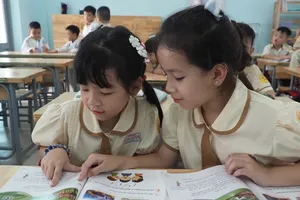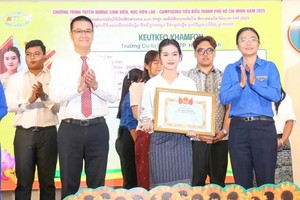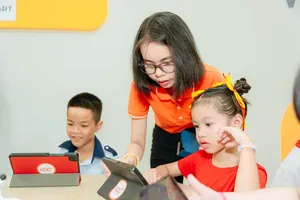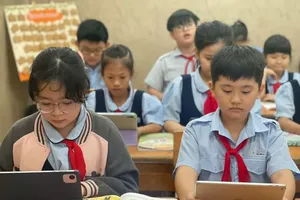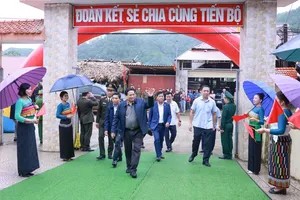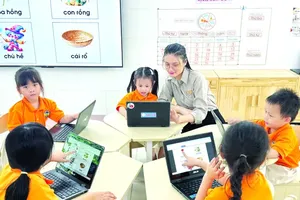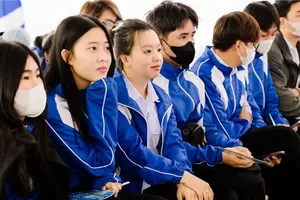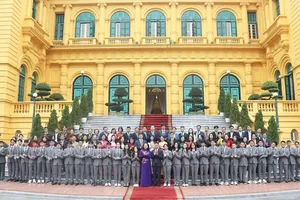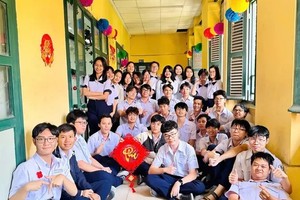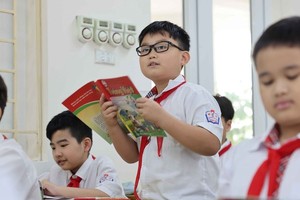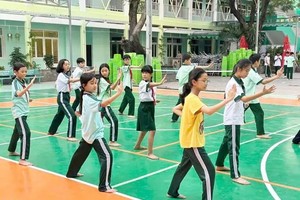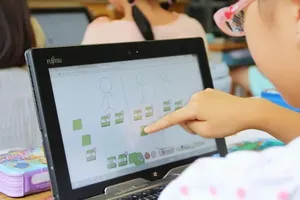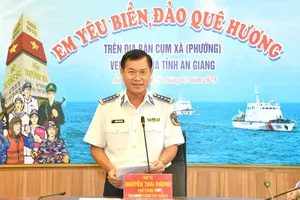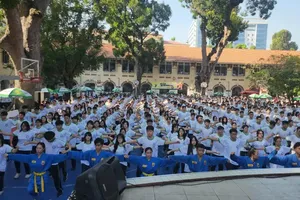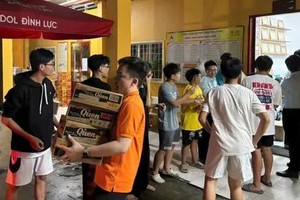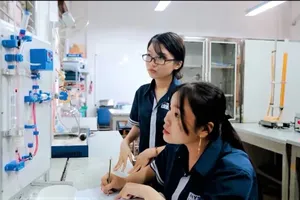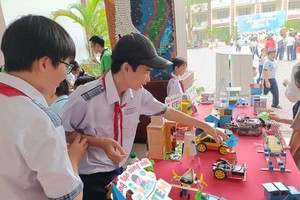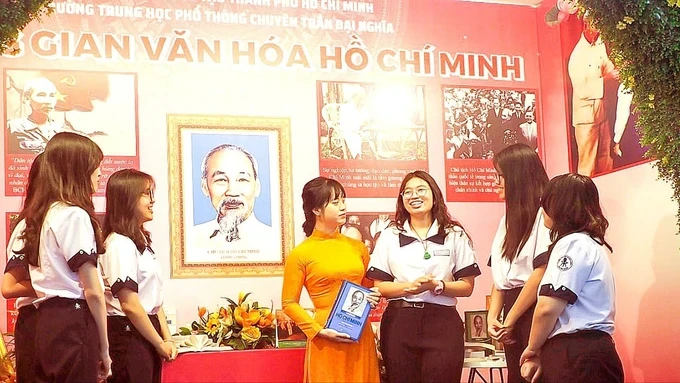
At Dang Tran Con Primary School in District 4, educators and students now benefit from a newly established learning space. The Ho Chi Minh cultural area is conceptualized with an open design, vividly reconstructing President Ho Chi Minh's life through vibrant, multicolored murals encompassing the school's courtyard.
The meticulously curated visual narrative spans diverse significant moments, from the serene Sen Village of his birth to the momentous Nha Rong Wharf where he embarked on his national liberation journey; from the revolutionary base of Pac Bo Cave in Cao Bang Province to the historic Ba Dinh Square where he proclaimed independence and established the Democratic Republic of Vietnam, as well as the iconic Ho Chi Minh Mausoleum. At each wall section, the school has strategically positioned expansive bookshelves, encouraging students to explore books across various disciplines.
At Truong Quyen Primary School in District 3, the Ho Chi Minh cultural space has transformed into a multidisciplinary learning environment for subjects like Vietnamese Language, History-Geography, Ethics, and Experiential Activities.
Vice Principal Tran La San emphasizes that by modifying the learning space, students can more effectively assimilate knowledge through vivid, tangible visual materials, simultaneously inspiring educators of various subjects to effectively exploit this space in the preparation of their lesson plans.
Teacher Nguyen Van Tan proposed that teachers of young students must smartly select teaching materials of various forms suitable for the comprehension of this age in order to turn seemingly boring lessons into intriguing and memorable learning moments.
Fifth-grade student Nguyen Hao Khang Kien expressively voiced his experience: "Previously, I had heard numerous stories about Uncle Ho, but learning within this cultural space—especially encountering images of him in his modest khaki attire, smiling and waving to fellow citizens and soldiers—made him feel extraordinarily intimate and endearing."
At Tran Dai Nghia High School for the Gifted in District 1, twelfth grader Le Hong Anh from class 12CV shared that she was born and raised in a peaceful time with a fast-paced and modern lifestyle. Studying in the Ho Chi Minh cultural space with various activities such as presentations, drama, makeup, and music composition has helped her better understand the indomitable fighting spirit of the ancestors, thereby appreciating the independence and freedom today and striving to be worthy of the bloodline of Lac Hong.
Head of the Civic Education - Economic Law Department at this school Bui Thi Tran Thy commented that in the context of deep integration with the world, students are inevitably influenced by foreign cultures. Therefore, it is necessary to motivate students to proactively explore the history and traditional cultural values of the nation to appreciate their beauty, closeness, and to have a sense of pride and preservation of good traditions.

Director Nguyen Van Hieu of the HCMC Department of Education and Training highly appreciate the efforts of all schools sited in the city in establishing their own Ho Chi Minh cultural space and transform these spaces into a place for organizing educational activities on morality and revolutionary ideals for students at all levels.
He also reminded that activities need to be effectively implemented, avoiding superficial or wasteful approaches. The deployment of Ho Chi Minh cultural spaces contributes to building a school culture, inspiring aspirations for the younger generation. In the coming time, schools need to integrate this space with the application of information technology and digital transformation to create both physical and non-physical cultural spaces to reach a wider range of students.
Statistics from the HCMC Department of Education and Training reveal that all schools located in HCMC have already introduced their Ho Chi Minh cultural space.
The city now has over 1,400 models and physical structures on display at schools, serving the teaching and learning of History, Literature, Regional Studies, Civic Education, and Experiential Activities.
Many schools have expanded the Ho Chi Minh cultural space to the schoolyard and corridors, innovating teaching methods to make lessons livelier.
Transforming into “4.0 Educator”
The 2024-2025 academic year marks the second consecutive period of educational institutions implementing technological integration and digital transformation in administrative and pedagogical activities. Within less than two academic years, the educational landscape has undergone a remarkable metamorphosis, encompassing initiatives such as electronic academic portfolios, expanding online learning modalities, and developing comprehensive digital lecture repositories.
Head Nguyen Son Hai of the IT Department (under the Education and Training Ministry) said that previously, many people had worried about the use of AI to replace teachers’ role, resulting in apprehension about adopting technology.
However, practical implementation reveals that technological tools represent potent pedagogical resources, with their utilization and extent being contingent upon individual educators' choice. AI does not replace educators; instead, teachers must undergo profound transformational processes to meet emergent educational imperatives.
“While we unequivocally acknowledge technological benefits, the key to success in each lesson is the pedagogical skills of the teacher combined with the support of technology. Thus, it is necessary to balance the technological factor and the teacher's role in control”, said Bui Thi Thuong, a literature teacher from Nguyen Hue High School in Ba Ria – Vung Tau Province.
Also, without appropriate policies for managing and using information technology, education can go astray. Therefore, training teachers is of paramount importance, both to promote their proactive role and to motivate them to continually innovate their thinking and teaching methods.
